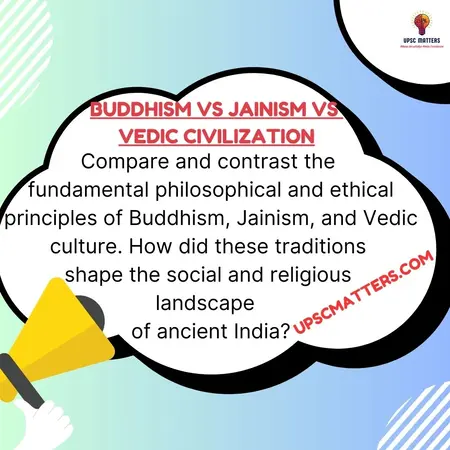Buddhism vs Jainism vs Vedic culture are three powerful intellectual and spiritual traditions that shaped ancient India. While Vedic culture laid the foundation of Hinduism, Buddhism and Jainism emerged as reformist movements that challenged rigid rituals and social hierarchies.
Question- Compare and contrast the fundamental philosophical and ethical principles of Buddhism, Jainism, and Vedic culture. How did these traditions shape the social and religious landscape of ancient India?
Buddhism Vs Jainism Vs Vedic Culture: A Philosophical and Ethical Principles
| Aspect | Buddhism | Jainism | Vedic Culture |
| Core Belief | Four Noble Truths & Eightfold Path | Non-violence & Liberation through Austerity | Ritualism, Polytheism, and Dharma |
| God Concept | No creator god, focus on individual enlightenment | No creator god, belief in souls | Worship of deities like Indra, Agni, Varuna |
| Karma & Rebirth | Actions determine rebirth, Nirvana as the goal | Strong karma doctrine, Moksha through extreme asceticism | Karma determines caste and next birth |
| Non-violence (Ahimsa) | Moderate approach, violence for self-defense allowed | Absolute non-violence (even in thoughts) | Sacrificial rituals included animal offerings |
| Caste System | Rejected caste hierarchy | Rejected caste system | Social stratification based on Varna |
| Rituals & Practices | Rejected Vedic rituals, emphasized meditation and morality | Rejected rituals, emphasized self-discipline | Fire sacrifices (Yajnas), prayers, and hymns |
| Role of Women | More inclusive, allowed women in monastic orders | Limited role, strict ascetic rules for women | Patriarchal structure, limited rights for women |
| Salvation (Moksha/Nirvana) | Nirvana through self-realization and meditation | Moksha through self-denial and renunciation | Attained through duty, rituals, and devotion |
Impact on the Social and Religious Landscape of Ancient India
- Challenge to Brahmanical Supremacy – Both Buddhism and Jainism questioned the dominance of Brahmins and their monopoly over religious knowledge, promoting a more egalitarian society.
- Spread of Non-Violence (Ahimsa) – Jainism’s extreme emphasis on non-violence influenced Indian ethics, leading to the decline of animal sacrifices in Vedic rituals.
- Rise of Monastic Traditions – The emergence of Buddhist Sanghas and Jain ascetic orders provided an alternative spiritual path beyond household life.
- Decline of Vedic Rituals – The criticism of elaborate rituals led to a shift towards Bhakti (devotional) traditions in later Hinduism.
- Art and Architecture – Buddhist stupas, Jain temples, and Vedic fire altars reflect the diverse religious expressions in ancient India.
- Patronage and Expansion – Mauryan rulers like Ashoka patronized Buddhism, while later rulers like the Guptas revived Vedic traditions, leading to coexistence and synthesis of these traditions.
Buddhism, Jainism, and Vedic culture significantly influenced Indian society by shaping its spiritual, ethical, and social values. While Buddhism and Jainism emerged as reformist movements, Vedic traditions evolved over time to accommodate new ideas. Together, these traditions enriched India’s pluralistic religious heritage and continue to impact its philosophical discourse.
For overall understanding of the Vedic Civilization you can refer to article- https://upscmatters.com/vedic-civilization-the-foundation-of-ancient-india/
If you found this helpful, you might also like these articles:
📌 [https://upscmatters.com/indus-valley-civilization/ ]
📌 [https://upscmatters.com/what-is-history/]
They cover key concepts that will boost your preparation! 🚀
📢 Stay Updated with the Best UPSC Resources!
Join our Telegram Channel for:
✅ Daily Current Affairs
✅ Important Notes & PDFs
✅ Answer Writing Tips
✅ Strategy & Motivation
📲 Click the link to join now: [https://t.me/upscmatters] or [https://t.me/ramsirnotes]
Don’t miss out on valuable updates! 🚀


Thank you, it was very informative and to the point information. Waiting for more such UPSC oriented initiatives..